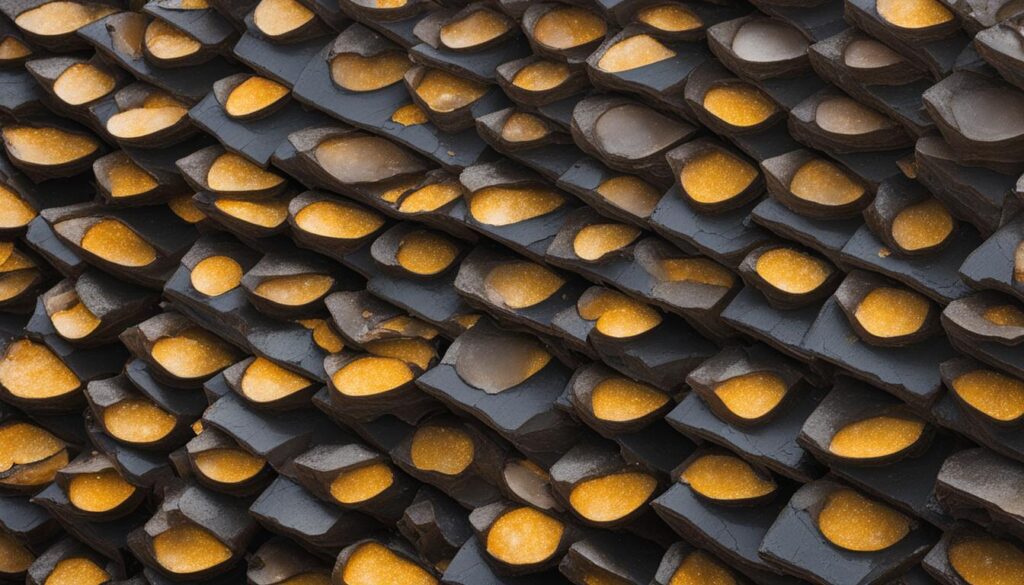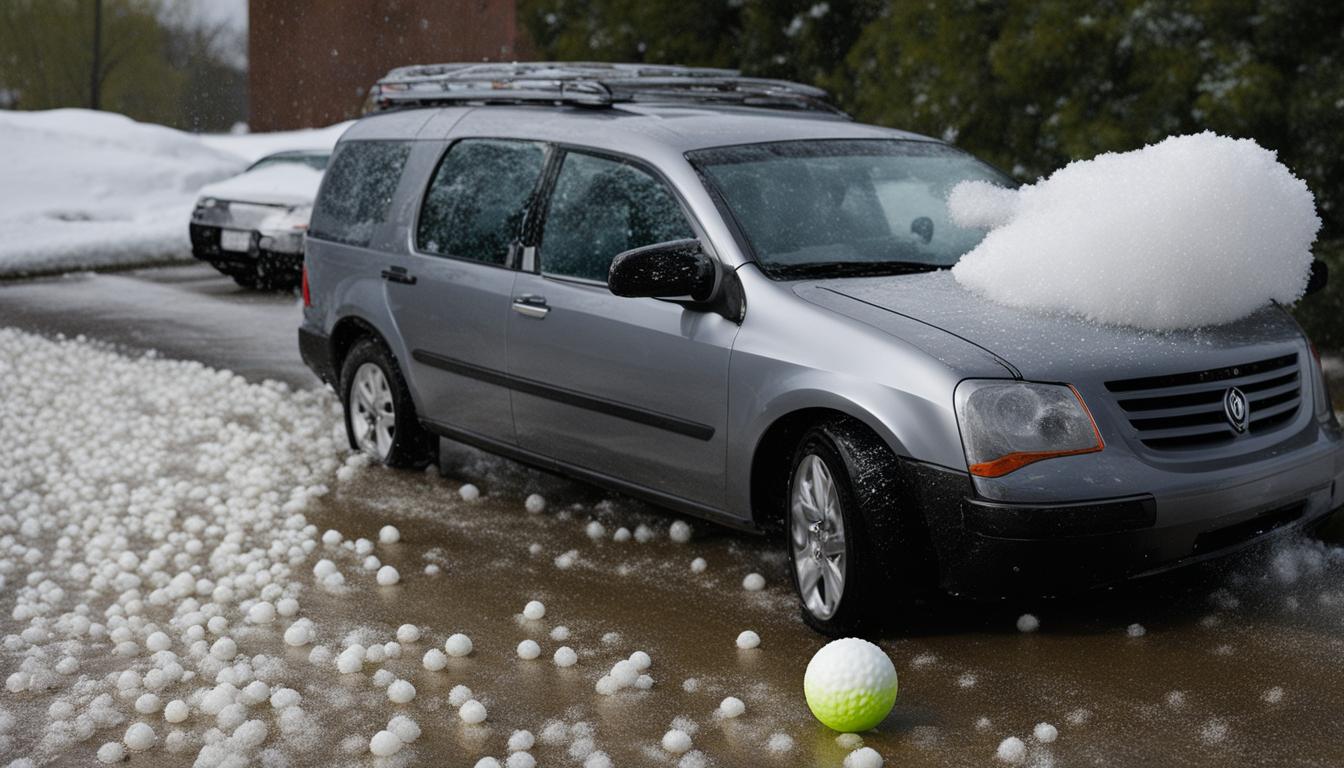Hail can cause significant damage, and the size of the hailstones plays a crucial role in determining its impact. According to the Northern Hail Project, different sizes of hailstones are associated with specific damage thresholds. Pea-sized hail, measuring under 10 mm, can result in crop damage, tree damage, storm drain blockage, and flooding. Even relatively small hailstones can be problematic, particularly in large volumes. City drainage systems can also be affected by heavy volumes of smaller hailstones, leading to blocked drainage and stripped foliage off trees.
Key Takeaways:
- Pea-sized hail, measuring under 10 mm, can cause crop damage, tree damage, and storm drain blockage.
- City drainage systems can be overwhelmed by large volumes of small hailstones, leading to blocked drainage and potential flooding.
- Understanding the differences in hailstone sizes is important for assessing potential risks and taking appropriate preventive measures.
- Protecting crops and trees from hail damage is crucial to ensure their healthy growth and productivity.
- Implementing preventive measures such as impact-resistant roofing materials and moving vehicles under cover during hailstorms can help minimize hail damage.
Risks of Pea-sized Hail
Pea-sized hail, measuring under 10 mm, poses various risks. It can cause damage to crops, especially during their early development stages. Certain sensitive crops may be particularly vulnerable to large volumes of pea-sized hail. Additionally, when there is a significant volume of small hailstones, city drainage systems can be overwhelmed, resulting in blockages and potential flooding. This type of hailstorm is colloquially referred to as a “snowplow hail event.”
Pea-sized hail can pose a serious threat to agriculture. In addition to damaging crops, it can also affect tree health. The impact of these small hailstones can strip foliage off trees and hinder their growth. The blocked drainage caused by the large volume of pea-sized hailstones can lead to flooding in urban areas. This underscores the importance of understanding the risks associated with different hailstone sizes and taking appropriate measures to mitigate them.
When pea-sized hail falls in significant amounts, it can disrupt normal drainage systems. Storm drains may become clogged, preventing proper water flow and increasing the risk of localized flooding. This can have a significant impact on urban areas, causing damage to infrastructure and properties. The accumulation of pea-sized hailstones can also lead to blockages in gutters and downspouts, further exacerbating the risk of flooding.
| Risks of Pea-sized Hail | Description |
|---|---|
| Crop Damage | Pea-sized hail can cause damage to crops, especially during their early development stages. |
| Tree Damage | The impact of pea-sized hailstones can strip foliage off trees and hinder their growth. |
| Storm Drain Blockage | Significant amounts of pea-sized hail can clog storm drains, leading to potential flooding in urban areas. |
Risks of Walnut-sized Hail
When it comes to hailstorms, hailstones measuring 30-35 mm, also known as walnut-sized hail, can pose significant risks to vehicles. These hailstones have the potential to cause visible dents, particularly on the roof of a car. However, it is important to note that it typically takes larger hailstones, generally 50 mm or larger in diameter, to cause window cracking in vehicles.
To better understand the risks associated with walnut-sized hail, let’s take a closer look at the potential damage it can inflict on vehicles:
| Impact | Risk |
|---|---|
| Dents on the car roof | High |
| Window cracking | Low |
As shown in the table above, the most significant risk associated with walnut-sized hail is the potential for dents on the roof of a car. Although window cracking is possible, it is less likely with hailstones of this size.
Therefore, it is crucial for car owners to be aware of the risks and take necessary precautions, such as parking vehicles in covered areas during hailstorms, to minimize the potential damage caused by walnut-sized hail.

Risks of Ping Pong/Golf Ball-sized Hail
Hailstones measuring 40-45 mm, also known as ping pong or golf ball-sized hail, can lead to damage to home roofing. Aged asphalt shingles are particularly vulnerable, and any type of roofing exposed to the sun for an extended period can experience visible damage. In addition to damage to shingles and other roofing materials, hailstones of this size can cause moisture penetration and promote mold growth.
The impact of ping pong/golf ball-sized hail on home roofing can be significant. Not only can it result in visible damage, but it can also weaken the structural integrity of the roof, making it more susceptible to leaks and other issues. Moisture penetration can occur, leading to water damage and the potential for mold growth. Homeowners should be aware of the risks associated with this size of hail and take the necessary precautions to protect their roofing.
Table: Comparison of Hailstone Sizes and Roofing Damage
| Hailstone Size | Damage to Home Roofing |
|---|---|
| Pea-sized (under 10 mm) | Potential damage to roofing materials, particularly when in large volumes |
| Walnut-sized (30-35 mm) | Dents and visible damage to roofing, especially on aging asphalt shingles |
| Ping Pong/Golf Ball-sized (40-45 mm) | Visible damage, moisture penetration, weakened structural integrity, and increased risk of mold growth |
| Baseball-sized (70 mm) | Potential catastrophic damage to roofing, including structural collapse |
It’s important for homeowners to regularly inspect their roofs for any signs of damage, especially after hailstorms. Prompt repair or replacement of damaged roofing materials can help prevent further issues and protect the integrity of the home. Consulting with a professional roofing contractor can provide valuable guidance on the best course of action and the use of impact-resistant materials to mitigate the risks associated with ping pong/golf ball-sized hail.
Risks of Baseball-sized Hail
Hailstones measuring around 70 mm in diameter, commonly referred to as baseball-sized hail, pose severe risks and potential damages. These larger hailstones can cause catastrophic damage to homes, vehicles, and even pose a risk of serious injury or death.
Impact on Homes
Baseball-sized hail can wreak havoc on residential properties. It can cause extensive damage to roofs, resulting in leaks, missing shingles, and compromised structural integrity. The impact from these massive hailstones can also break windows and damage siding, leading to increased repair costs and potential water damage inside the home.
Impact on Vehicles
When baseball-sized hail falls, vehicles are highly susceptible to damage. The force of the hail can shatter windshields, dent car bodies, and even cause total loss in severe cases. Repairing the damage caused by baseball-sized hail can be costly, and in some cases, the vehicle may be deemed irreparable.
Risks to Life and Safety
Perhaps the most alarming risk associated with baseball-sized hail is the potential threat to lives and safety. The impact of these large hailstones can cause serious injury or even death if individuals are caught outdoors during a hailstorm. Windshields can shatter upon impact, and the force of the hailstones can be lethal.
| Severity | Damage |
|---|---|
| Home | Catastrophic damage to roofs, windows, and siding |
| Vehicle | Extensive dents, shattered windshields, potential total loss |
| Life and Safety | Potential risk of serious injury or death |
Given the severity of the risks associated with baseball-sized hail, it is crucial for individuals to heed emergency alerts and seek shelter immediately when such hail is expected to fall. Taking proactive measures to protect homes and vehicles, such as installing impact-resistant roofing materials and parking vehicles in covered areas, can help mitigate the potential damages caused by this size of hail.
Hail Damage and Cost
Hail is a major contributor to costly damage in regions prone to severe storms. The Institute for Catastrophic Loss Reduction estimates that hail has caused $9.5 billion in insurable damage in Canada since 2008. The hailstorm that hit northeast Calgary in June 2020 alone caused an estimated $1.4 billion in damages.
When assessing hail damage, insurance companies consider factors such as the size of the hailstones, the duration of the storm, and the vulnerability of the affected property. Insured damage costs can vary significantly depending on these factors and the specific insurance policies in place.
Preventive measures can help minimize the impact of hail damage. For roofs, using materials with impact resistance ratings like Class 4 shingles can reduce the risk. These shingles are designed to withstand hailstorms and can help protect against damage. Impact-resistant windows and films can also be installed to safeguard against shattered glass. Additionally, moving vehicles under cover during hailstorms can help prevent damage to cars and trucks.
| Hail Damage Assessment | |
|---|---|
| Factors Considered | Size of hailstones, duration of storm, vulnerability of property |
| Insured Damage Costs | Varies depending on factors and insurance policies |
By taking proactive steps to protect against hail damage, individuals and communities can reduce the financial impact of severe storms. It is essential to stay informed about local weather conditions and be prepared to implement necessary protective measures when hailstorms are anticipated.

Preventive Measures Against Hail Damage
- Use impact-resistant materials for roofs, such as Class 4 shingles, to reduce the risk of damage.
- Install impact-resistant windows and films to protect against shattered glass.
- Move vehicles under cover during hailstorms to prevent damage.
- Stay informed about local weather conditions and be prepared to take necessary protective measures.
The Importance of Preparedness
When it comes to hailstorms, being prepared and taking protective measures can make a significant difference in minimizing the potential risks and damages. Understanding the different hailstone sizes and their corresponding risks is crucial in developing effective preparedness strategies. By implementing impact-resistant materials for roofs, windows, and siding, individuals and communities can greatly reduce the risk of damage.
One of the key aspects of hailstorm preparedness is using impact-resistant materials for roofs. Materials such as Class 4 shingles are specifically designed to withstand hail impact. These shingles have been tested and rated to withstand hailstones of a certain size, providing enhanced protection for homes. Similarly, impact-resistant windows and films can protect against shattered glass, reducing the risk of injury and property damage.
In addition to using impact-resistant materials, taking preventive measures such as moving vehicles under cover during hailstorms can also help mitigate damage. Parking vehicles in a garage or carport during severe weather can provide a layer of protection against hailstones, reducing the risk of dents and broken windows. If a covered parking option is not available, seeking shelter under a sturdy structure or using a hail blanket can provide some level of protection.

Investing in hailstorm preparedness measures may involve upfront costs, but the long-term benefits and reduced repair costs make it a worthwhile investment. Particularly in areas frequently impacted by large hailstorms, being prepared can help safeguard lives and properties. By understanding the risks, implementing protective measures, and staying informed about potential hailstorms, individuals and communities can greatly reduce the impact and risk associated with hailstone sizes.
Conclusion
In conclusion, the size of hailstones has a significant impact on the potential risks and damages they can cause. From pea-sized hail that can lead to crop and tree damage, to walnut-sized hail that can dent vehicles, and ping pong/golf ball-sized hail that can damage home roofing, each size presents its own set of risks. However, the most severe risks come with baseball-sized hail, which can result in catastrophic damage, serious injury, or even death.
To minimize the impact of hail damage, it is crucial to take preventive measures. Using impact-resistant materials for roofs, windows, and siding can greatly reduce the risk of damage. Additionally, moving vehicles under cover during hailstorms can help prevent costly hail-related repairs. Being prepared and aware of the potential risks associated with different hailstone sizes is essential for protecting lives and properties.
By understanding the impact of hailstone sizes and implementing damage prevention strategies, individuals and communities can mitigate the destructive effects of hailstorms. While the upfront costs of protective measures may be higher, the long-term benefits and reduced repair costs make these investments worthwhile, especially in areas frequently affected by large hailstorms. Remember, prevention is key when it comes to hail damage, and being proactive can help safeguard against potential losses.
FAQ
What is the difference between hail sizes, pea vs golf ball?
The difference between hail sizes refers to the size of the hailstones. Pea-sized hail measures under 10 mm, while golf ball-sized hail measures 40-45 mm in diameter.
What are the risks of pea-sized hail?
Pea-sized hail can cause damage to crops, trees, and storm drains. The volume of small hailstones can lead to blocked drainage and potential flooding.
What are the risks of walnut-sized hail?
Walnut-sized hail can cause visible dents in vehicles, especially on the roof. Larger hailstones, usually 50 mm or larger in diameter, are required to cause window cracking in vehicles.
What are the risks of ping pong/golf ball-sized hail?
Ping pong/golf ball-sized hail can cause damage to home roofing, particularly aged asphalt shingles. It can also cause moisture penetration and promote mold growth.
What are the risks of baseball-sized hail?
Baseball-sized hail presents the most significant risks, including catastrophic damage to homes and vehicles. It can shatter windshields and cause serious injury or even death.
How much damage has hail caused?
Hail has caused $9.5 billion in insurable damage in Canada since 2008. The June 2020 hailstorm in northeast Calgary alone caused an estimated $1.4 billion in damages.
How can hail damage be prevented?
Taking preventive measures, such as using impact-resistant materials for roofs and windows, can help minimize hail damage. Moving vehicles under cover during hailstorms is also recommended.
Why is preparedness important?
Being aware of the risks associated with different hailstone sizes and taking protective measures can help individuals and communities reduce the impact of hail damage on lives and properties.



